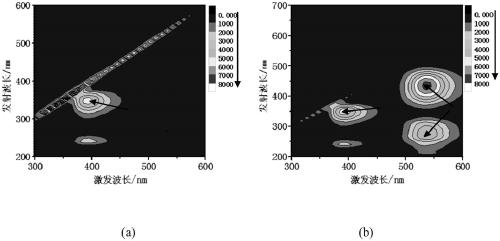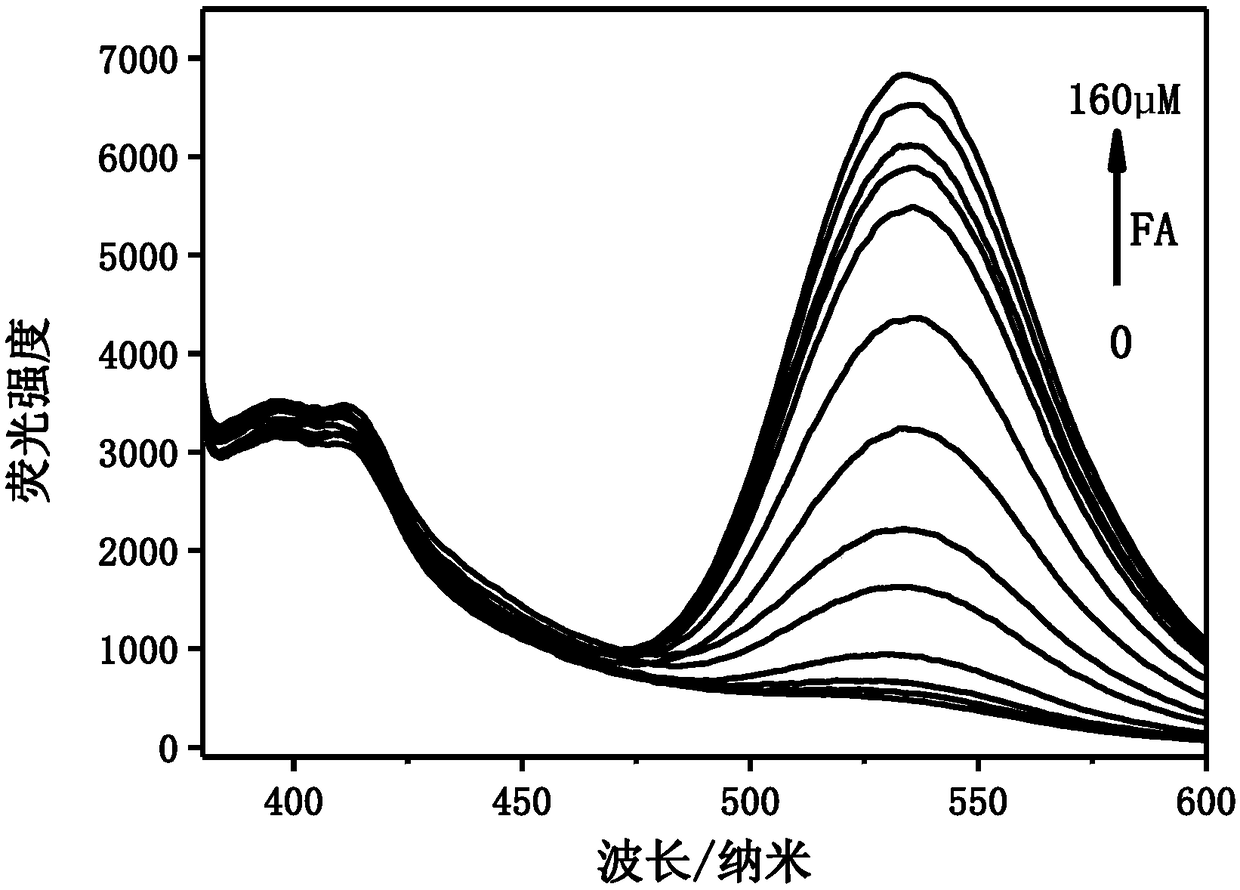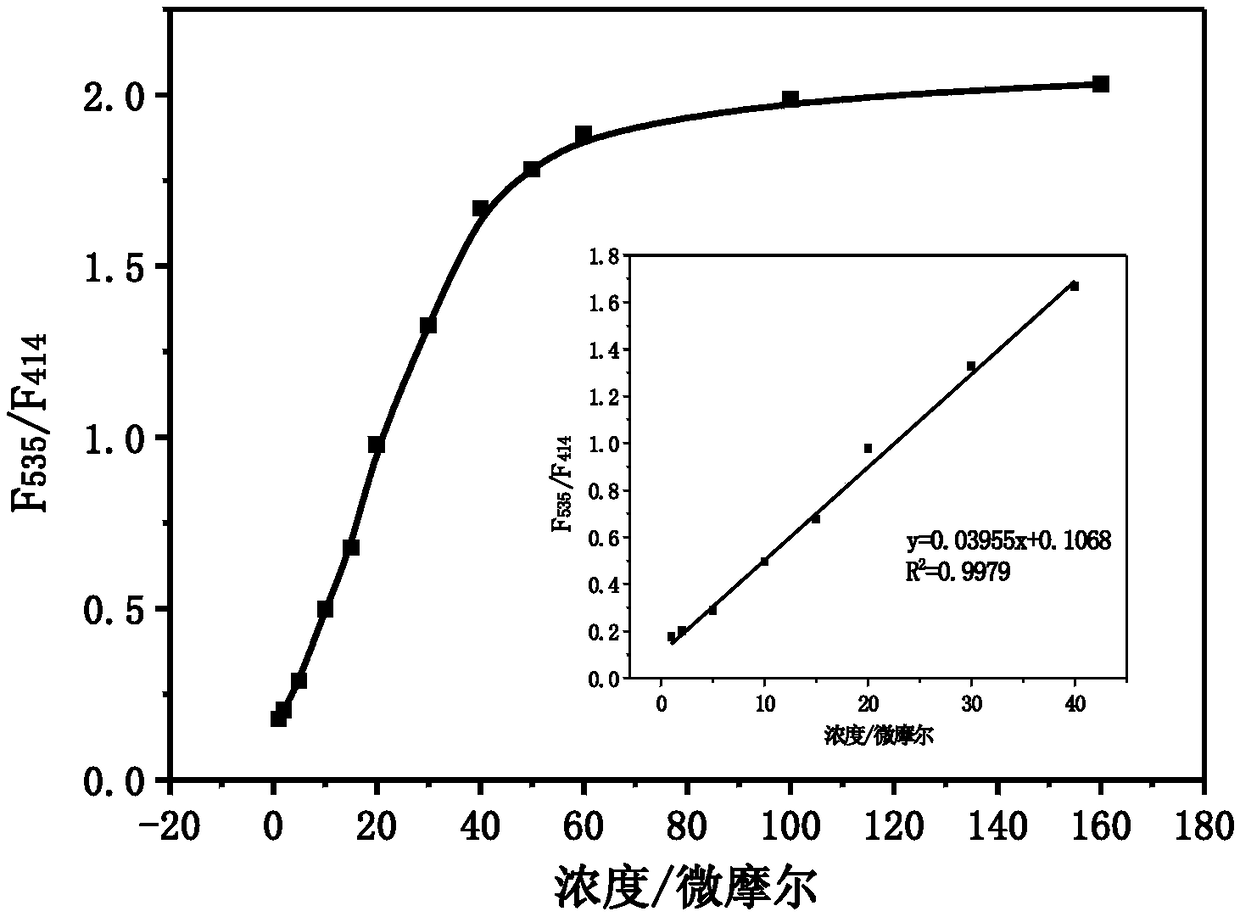Fluorescence ratio probe as well as synthesis method thereof and application thereof to detection on intracellular lysosomal formaldehyde
A technology of fluorescent ratio probes and synthesis methods, which is applied in the directions of fluorescence/phosphorescence, chemical instruments and methods, and luminescent materials. Targeting, good water solubility, and high sensitivity
- Summary
- Abstract
- Description
- Claims
- Application Information
AI Technical Summary
Problems solved by technology
Method used
Image
Examples
Embodiment 1
[0057] Embodiment 1: the synthetic method of compound CDs-NA comprises the following steps:
[0058] Step 1: Preparation of methionine carbon dot solid powder
[0059] Weigh 0.8g of methionine and 1g of citric acid into a 20mL small beaker, slowly add 5mL of secondary water and stir evenly with a glass rod to dissolve them. After the dissolution is complete, the reaction solution is obtained;
[0060] All the reaction solution was transferred to a 25mL reaction kettle, and a steel jacket was installed, and the reaction was heated at 200°C for 3h in a forced air drying oven. After the reaction was completed, it was cooled to room temperature to obtain a mixed solution.
[0061] Next, the mixture was aspirated and centrifuged at a speed of 12000r / min for 15 minutes to remove non-fluorescent large particles and obtain a supernatant of carbon dots for future use.
[0062] Then, the supernatant was dialyzed with a dialysis bag with a molecular weight cut-off of 500D for 12 hours t...
Embodiment 2
[0074] Embodiment 2: Fluorescence ratio probe CDs-NA changes with the addition of fluorescence spectrogram of different amounts of formaldehyde
[0075] Use PBS (10mM, pH 7.4) as a solvent, and prepare a concentration of 0.1mg mL -1 CDs-NA in PBS solution. Add 100 μL of formaldehyde solutions of different concentrations (0, 1, 2, 5, 10, 15, 20, 30, 40, 50, 60, 100, 160 μM) to the centrifuge tube containing 400 μL of CDs-Na in PBS solution, and shake for 30 minutes . Using a cuvette with an optical path of 0.5 cm, a fixed excitation wavelength of 365 nm, and a photomultiplier tube voltage of 650 V, measure its fluorescence emission spectrum with a Hitachi F-7000 fluorescence spectrophotometer, and the probe CDs-NA of different amounts of formaldehyde For changes in the fluorescence spectrum, see figure 2 ,From figure 2 It can be seen that with the increase of formaldehyde concentration, the fluorescence peak at 414nm remains unchanged, while the fluorescence peak at 535nm...
Embodiment 3
[0076] Embodiment 3: the calculation of probe CDs-NA detection formaldehyde lower limit
[0077] According to the fluorescence spectrogram of example 2, the fluorescence intensity ratio (F) of the fluorescence intensity at the 535nm place and the 414nm place 535 / F 414 ) and the corresponding formaldehyde concentration, see image 3 . Depend on image 3 Visible, formaldehyde concentration is 0-40μmol / L, F 535 / F 414 Good linearity with formaldehyde concentration. According to the formula Dl=3σ / k (Dl is the lower limit of detection, σ is the standard deviation of the intercept, and k is the slope), the lower limit of detection can be calculated as 338nM.
PUM
 Login to View More
Login to View More Abstract
Description
Claims
Application Information
 Login to View More
Login to View More - R&D
- Intellectual Property
- Life Sciences
- Materials
- Tech Scout
- Unparalleled Data Quality
- Higher Quality Content
- 60% Fewer Hallucinations
Browse by: Latest US Patents, China's latest patents, Technical Efficacy Thesaurus, Application Domain, Technology Topic, Popular Technical Reports.
© 2025 PatSnap. All rights reserved.Legal|Privacy policy|Modern Slavery Act Transparency Statement|Sitemap|About US| Contact US: help@patsnap.com



